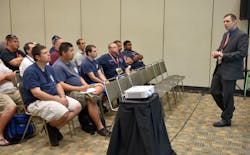BALTIMORE Md. – Fire is like gravity, it follows laws of physics which means there is no such thing as extreme fire behavior. It’s more likely fire behavior the observer never previously experienced.
Robin Zevotek, P.E., a Research Engineer III at Underwriters Laboratories (UL), gave a presentation at Firehouse Expo Thursday entitled “Modern Fire Behavior, Today’s Fire Environment.” In his presentation he explained that today’s fires burn much hotter and faster than fires of yesterday, but they still burn the same way.
Firefighters who fought legacy fires, with legacy furniture in homes made of heavy building materials had much more time to attack the fire which typically burns slower, Zevotek said. Additionally, most firefighters had very little schooling in fire behavior.
Zevotek pointed out that firefighters with Level I and Level II certification have only a total of three hours of fire behavior and that covers everything including fire extinguisher use and the fire tetrohedon.
“How many of you had high school teachers who only used a textbook and never handed out a pamphlet or used a video as extra material,” Zevotek questioned. No one responded affirmatively.
He pointed out, however, the two most popular books used for firefighter certification were written by firefighters and have been in use for decades. Research is part was part of the publishing process, but it wasn’t a big component.
“We really need to take a hard look at where we get our information from,” Zevotek said, adding that education needs to be supported by research like the kind that UL performs.
Zevotek said UL now has five people dedicated to doing research that will help protect firefighters now and in the future. Fortunately, UL’s mission to keep people safe in their homes and the work place and for firefighters, homes are often the work place during fires, he said.
“So, it’s not too much of a jump for us to do both,” he said.
UL’s research has shown that modern fires burn much faster than legacy fires and, consequently, firefighter fatalities are increasing proportionally.
In the late 1970s, there were 1.8 traumatic deaths per 100,000 fires compared to three deaths per 100,000 fires in the late 2000s, Zevotek said, adding that the number of fires has actually decreased by 53 percent in the same time.
Today’s homes are larger with more open space and engineered lumber which is a recipe for fast moving fires, he said, noting that the homes are also filled with synthetic materials, like kids toys and plastic laced furniture.
The additional space, not only in square footage, but in construction void spaces, allows more oxygen to enter the fires and burn hotter and faster, he said. And, the open concept designs means there’s less drywall or Sheetrock to act as fire barriers, he added.
Building fires can now go from inception to flashover in less than 15 minutes, much less in some cases, Zevotek said, noting that the average response time is about eight minutes in the US. That gives firefighters sometimes just seconds to get a knock on a fire and put it out. Fires in legacy homes grow much slower and can go for almost 30 minutes before flashing, he said.
Zevotek also spoke of the importance of knowing about fire flows and predicting where and when they’ll happen, and most importantly, staying out of them.
He also gave a primer on how turnout gear works to keep firefighters safe and to give them more time to battle fire – which is important given the reduced time afforded by modern materials and modern construction designs.
As a former firefighter himself, Zevotek said he wishes he had the knowledge he has today because it would have helped him do his job better.
“If I knew where I could go and how long I could stay, that would have made a huge difference in how I fought fire,” Zevotek said.
He stressed the importance of controlling oxygen flow to a fire and knowing when to vent and when not to vent. Keeping the front door two-thirds closed after making entry to a burning building will help control the fire flow coming back to the front door and injuring firefighters. He cautioned about the need to keep someone at the front door to make sure the door stays partly closed.
“We all know what happens when we put a two and half gate at the door, it gets closed,” Zevotek said.
Mismanaging or incorrectly predicting fire flow can spell disaster not only for victims and firefighters, but for the property as well, he said, adding that firefighters should experiment with fire flows the next time they get an acquired structure to burn.
“You can burn down a structure really nicely if you try,” Zevotek quipped. Firefighters with axes that randomly take out window or police officers trying to break windows with their batons looking for victims can raise havoc on fire flows.
“That’s why it is critically important to have a coordinated ventilation where everyone works together,” Zevotek said.
Zevotek stressed the importance of education and trusting the sources of information. The fire service has lots of people who teach lots of things and not all of it is backed by research and some is just opinion.
“You need to have an understanding of what you are doing before you do it,” he said. “I am not telling you to do away with your truck companies or never go into a burning building. I am telling you to know what you’re doing before you do it.”






